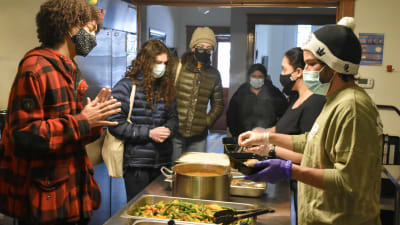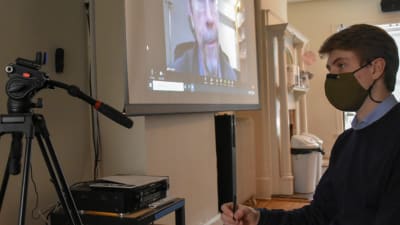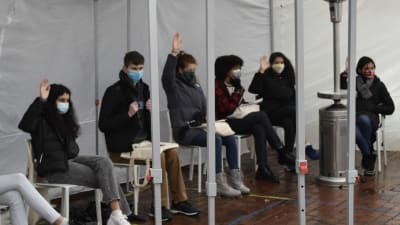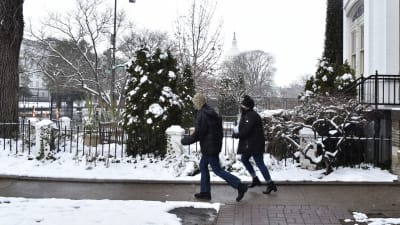Critical Thinking and Media Bias: Week One in DC!
Is that true? Is that right? Answering these questions, especially in 2021, requires perseverance. What’s a responsible young leader to do?
At SEGL, we tell students to follow the STAR.
STAR is SEGL’s critical thinking framework: SEE – THINK – ACT – REFLECT. This four-step process (inspired in part by Harvard’s Project Zero) helps students evaluate information and choices in our era of misinformation.
We spent most of our first week together learning how to see: Through which filters do we see the world, and how do those filters affect how we gather information? How do we gather information as objectively as possible, without jumping to conclusions? How do we see, clearly, before we think?
Focusing young leaders on critical thinking skills is particularly important in the wake of January 6th, 2021. Indeed, that day informed each of our first week pedagogical choices.
Much of our critical thinking work considered media bias and literacy. All four of our guest speakers were noted journalists, and the week’s culminating “deliverable” put ethical journalism front and center.
Our first activity helped students understand the challenge of modern news production and consumption: after asking each student to write down the news sources she or he used most, we asked all students to arrange those sources on a matrix. On the “x axis” of that matrix was the liberal-conservative spectrum; on the y-axis how reliable each source was. The results were fascinating and showed both assumptions and blind spots in our group’s favorite news sources. The most popular quadrant was “liberal and reliable.” But can news be both politically biased and trustworthy? The session also helped create many questions for the guest experts that followed.
We then told the students that on Thursday they would face their biggest SEGL challenge yet: a day-long, hands-on journalism simulation. Their success would depend on how well they put their newfound critical thinking skills to work.
To provide further preparation, we turned to two young journalists with impressive careers. Leah Askarinam, Editor-in-Chief of the National Journal Hotline; she has previously worked at the Atlantic, Inside Elections, NBC News, and more. Thomas Stackpole is a Senior Editor at the Harvard Business Review; he previously worked at The New Republic, Smithsonian, Mother Jones, and Foreign Policy. (You can read a piece he wrote several years ago for Smithsonian magazine here.) Both journalists gave mini-clinics on key journalism skills (here’s a short video from Stanford on “reading laterally,” one of the skills our students are practicing) and then answered questions.
Later in the week, we welcomed two journalists with four Pulitzer Prizes between them. First we met with three-time Pulitzer Prize-winning journalist Eric Schmitt at The New York Times. Among other distinctions, Schmitt was the Times‘ main contact for WikiLeaks founder Julian Assange, and once climbed into Saddam Hussein’s final hiding place (without permission!). Schmitt has ample experience wrestling with the ethical issues our case study raised. The students heard stories, his take on President Trump and the current media landscape, and his advice for news readers in the “fake news” era.
We also met with Rebecca Ballhaus, who covers the White House and does investigative reporting for the Wall Street Journal. Ballhaus shared a Pulitzer Prize in 2019 for her coverage of President Trump’s payments from attorney Michael Cohen to adult film star Stormy Daniels. Among other observations, the similarities and differences between Ballhaus (who is younger, female, and writes for a paper some consider to lean right) and Schmitt (who is older, male, and writes for a paper some consider to lean left) were fascinating for students to see.
On Thursday morning it was showtime: the day-long journalism simulation. In groups of four, the students traversed Lincoln Park (a few blocks from our residence), transformed into an imaginary Central Asian autocracy with a breakaway rebel province. Our faculty played various key leaders in what turned out to be a dramatic series of events. The catch? Through shrewd observation, questioning, and research, our students had to figure out which (if any) of the leaders to believe. The day culminated in three-minute on-the-scene video presentations in which each group decided what to share, and how.
As we worked though our study of the media, we also went deeper in to the STAR critical thinking model. For example, a Tuesday trip to Lincoln Park focused on a sculpture in the park’s center that earned national attention last year: the Emancipation Memorial. The Memorial depicts the moment President Lincoln formally emancipated American slaves. Until a few months ago, concrete slabs and black fences covered with signs surrounded the monument. (Soon after the barriers were removed, a stolen BMW slammed into the monument’s side, adding additional intrigue.)
Should it stay? Be destroyed? Move to another location? Include an explanatory plaque? This is the A (“ACT”) of our STAR. The session was a fascinating hands-on critical thinking experience, full of twists and turns as students dug beyond their first impressions. (To read Frederick Douglass’s dedication of the monument–itself a model of critical thinking–click here.) You can read a more in-depth post (written several semesters ago) about our lesson plan here.
That afternoon, students broke into rotating discussion groups and cycled through different “SEE” activities designed to bolster their critical thinking toolkit. What stories, experiences, and biases are you carrying that might influence how you see something? What images, interviews, and storylines has this news source curated for you, and what more would you like to see? How can sharing your working viewpoint with a trusted colleague help you see even more?
We also spent time directly addressing January 6th, 2021.
We began that focus with some ethical groundwork: The Infamous Skittles Scenario (an early SEGL rite-of-passage!) was an entertaining start. The interactive state-of-nature simulation has students chasing after plastic bags of candy and shouting with delight or dismay at 3×5 “Chance” cards. (What would you do if there were no rules and limited resources? Would you use that gun you found? Help out a suddenly-blind friend? Lie? Join a makeshift band of marauders? Form a “collective” that might turn sour if resources are light?) The conversation that followed was both reflective and energetic.
More important, it helped students answer the question, “Why form a government?” A post-Skittles lecture discussed Social Contract Theory and the philosophers Hobbes, Locke, and Rousseau. Each of these thinkers ties his ideal form of government to his account of human nature. Are we naturally selfish, altruistic, or something in-between? The students used their Skittles experience to answer.
We followed this exploration with rotating discussion groups addressing different types of government: which form is best? And then we discussed the legal, illegal, ethical, and unethical ways that citizens seek to perfect (and, occasionally, destroy) our American “social contract.” These small-group discussions brought students forward to some of January 6th’s key questions. Were that day’s insurrectionists any different from the American Revolution’s leaders? From last summer’s demonstrators and rioters? What role did race play? The conversations were terrific and well-informed.
All in all, it has been a busy and promising start to the spring!
Next up: a case study we developed during last summer’s national conversation on race, and our first meeting with a Member of Congress (who was on the House floor on January 6th). More on that soon!













































